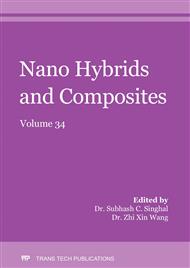[1]
Du, W., et al., Study of Si-Based GeSn Optically Pumped Lasers With Micro-Disk and Ridge Waveguide Structures. Frontiers in Physics, 2019. 7(147): p.7.
DOI: 10.3389/fphy.2019.00147
Google Scholar
[2]
Fang, C., et al., Germanium-tin alloys: applications for optoelectronics in mid-infrared spectra. Opto-Electronic Advances, 2018. 1(3): p.180004.
Google Scholar
[3]
WirthsS, et al., Lasing in direct-bandgap GeSn alloy grown on Si. Nat Photon, 2015. 9(2): pp.88-92.
Google Scholar
[4]
Homewood, K.P. and M.A. Lourenco, Optoelectronics: The rise of the GeSn laser. Nat Photon, 2015. 9(2): pp.78-79.
Google Scholar
[5]
Basu, R., et al., Predicted performance of Ge/GeSn hetero-phototransistors on Si substrate at 1.55\,\upmu \mathrm{m}. Optical and Quantum Electronics, 2015. 47(2): pp.387-399.
DOI: 10.1007/s11082-014-9921-3
Google Scholar
[6]
Coppinger, M., et al., Photoconductivity of germanium tin alloys grown by molecular beam epitaxy. Applied Physics Letters, 2013. 102(14): p.141101.
DOI: 10.1063/1.4800448
Google Scholar
[7]
Xiao, G., et al., Germanium–Tin (GeSn) p-Channel MOSFETs Fabricated on (100) and (111) Surface Orientations With Sub-400 oC Si2H6 Passivation. Electron Device Letters, IEEE, 2013. 34(3): pp.339-341.
DOI: 10.1109/led.2012.2236880
Google Scholar
[8]
Soref, R., Direct-bandgap compositions of the CSiGeSn group-IV alloy. Optical Materials Express, 2014. 4(4): pp.836-842.
DOI: 10.1364/ome.4.000836
Google Scholar
[9]
Wang, D., et al., Semiconducting SiGeSn High-Entropy Alloy: A Density Functional Theory Study. Journal of Applied Physics, (2019).
Google Scholar
[10]
Moontragoon, P., R.A. Soref, and Z. Ikonic, The direct and indirect bandgaps of unstrained SixGe1−x−ySny and their photonic device applications. Journal of Applied Physics, 2012. 112(7): p.073106.
DOI: 10.1063/1.4757414
Google Scholar
[11]
Yu, M.T., et al., Machine learning the Hubbard U parameter in DFT plus U using Bayesian optimization. Npj Computational Materials, 2020. 6(1): p.6.
DOI: 10.1038/s41524-020-00446-9
Google Scholar
[12]
Niu, Hu,et al.Application of Machine Learning in Material Informatics: A survey [J]. Materials Reports,2020,34(23):23100-23108.
Google Scholar
[13]
Tibshirani R. Regression shrinkage and selection via the lasso: A retrospective. J R Stat Soc Ser B Stat Methodol, 2011, 73: 273–282.
DOI: 10.1111/j.1467-9868.2011.00771.x
Google Scholar
[14]
Chun Song Jiang and Gui Qin Liang. Modeling shear strength of medium- to ultra-high-strength concrete beams with stirrups using SVR and genetic algorithm[J]. Soft Computing, 2021: 1-15.
DOI: 10.21203/rs.3.rs-338840/v1
Google Scholar
[15]
Zhang Jialin et al. FS-GBDT: identification multicancer-risk module via a feature selection algorithm by integrating Fisher score and GBDT. [J]. Briefings in bioinformatics, 2021, 22(3).
DOI: 10.1093/bib/bbaa189
Google Scholar
[16]
BREIMAN L. Random forests[J]. Machine Learning, 2001,45(1): 5-32.
Google Scholar
[17]
Zheng, Zhang, et al. different machine learning algorithms different machine learning algorithms. [J]. The Chinese Journal of Nonferrous Metals,2019,29(04):803-809.
Google Scholar
[18]
Liu Yaru and Wang Lei and Gu Kaixuan. A support vector regression (SVR)-based method for dynamic load identification using heterogeneous responses under interval uncertainties[J]. Applied Soft Computing Journal, 2021, 110.
DOI: 10.1016/j.asoc.2021.107599
Google Scholar
[19]
Zhang Yuefei et al. Development of an SVR model for microwave-assisted aqueous two-phase extraction of isoflavonoids from[J]. Chemical Engineering Communications, 2021, 208(7): 1005-1016.
DOI: 10.1080/00986445.2020.1734578
Google Scholar
[20]
Liu Yaru and Wang Lei and Gu Kaixuan. A support vector regression (SVR)-based method for dynamic load identification using heterogeneous responses under interval uncertainties[J]. Applied Soft Computing Journal, 2021, 110.
DOI: 10.1016/j.asoc.2021.107599
Google Scholar
[21]
Zhang Wanhu et al. Predictive model of cooling load for ice storage air-conditioning system by using GBDT[J]. Energy Reports, 2021, 7: 1588-1597.
DOI: 10.1016/j.egyr.2021.03.017
Google Scholar


